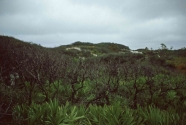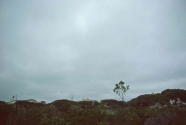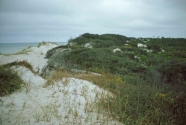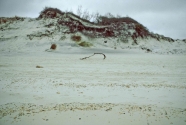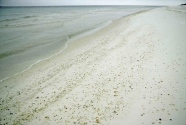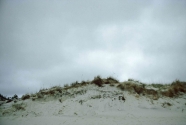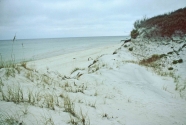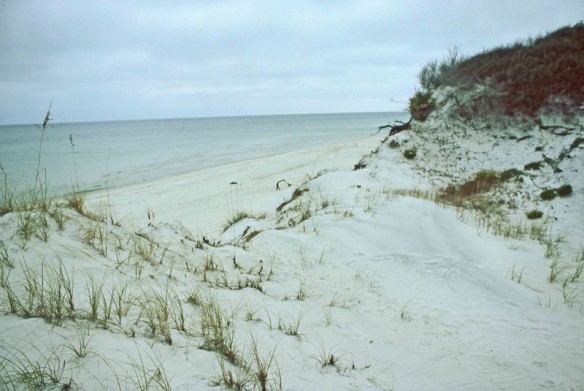
By Celie Dailey;
The remote Cape San Blas on the Florida Panhandle is photographed here in the fall. Huge vegetated dunes and many trails for exploration can be easily accessed from the tent sites at St. Joseph State Park. Pine forest is the setting of the camp.
Cape San Blas is a cuspate foreland, a body of sand in a triangular formation, similar in shape to the Carolina capes and Cape Canaveral. (1) On the Apalachicola River Delta, Cape San Blas is part of a barrier island chain along Florida’s northwest coast that stretches westward, across the bay of Mobile, AL. Cape San Blas is the southernmost headland at the “elbow” of two peninsulas, called “unstable strips of sand” in the text Living on the Edge of the Gulf, Duke University Press. (6) To the west is St. Joseph peninsula, mostly about half a mile wide, bordering St. Joseph Bay, and to the east of Cape San Blas is Indian peninsula. Further east is another set of barrier islands in a triangular formation—Saint Vincent Island, Saint George Island, and Dog Island.
Shoals feed the islands with sand. The source of the large shoals of sand “extending seaward from each cape” is “somewhat of an enigma to coastal geologists,” according to the text Living with Florida’s Atlantic Beaches, Duke University Press. (1) Likely, a river delta formed when the sea level was lower, and later flooded with the rising seas.
Much of “the sand on the Panhandle coast derives from rivers as far away as the southern Appalachians and Piedmont,” reflected in the build up of the Apalachicola River Delta, which was “derived long ago from sources that are no longer adding new sand to the overall system.”(4,5)
“Erosion is not a problem for beaches; erosion is only a problem for us, when there are structures at stake or loss of property.”
— Celie Dailey
Before the sand supply ceased about the end of the Pleistocene Ice Age, river sands “made it as far as the Alabama-Florida Panhandle and were incorporated into the barrier island coast” along the Gulf Coastal Plain. (3) With “very limited sand reserves” on the continental shelf, the west Florida “barrier islands depend for their existence largely on the reworking of their own sands and sand from associated tidal deltas.” (3)
The dunes at Cape San Blas are about 10-15 feet high, but the northern part of St. Joseph Peninsula has dunes generally about 20-30 feet high, with dunes “in excess of 50 feet in one area”. (6) According to the Duke University text: “Some sections of St. Joseph Peninsula have been nourished in the past, but the souther part, just north of Cape San Blas, has been eroding at rates up to 15 feet per year. The southernmost 3-mile portion of the cape is the most rapidly eroding shoreline in Florida, average 25 feet per year for the 150-year period of record…. The Cape San Blas lighthouse has been relocated six times!” (7)
On Cape San Blas, “the state and federal lands are undeveloped, but much of the remainder of the peninsula is developed with both single-family and multifamily dwellings,” according to the Duke University text. County wide, nearly 17 miles of “Gulf-front beaches on both St. Joseph and Indian Peninsulas” are eroding. Erosion is not a problem for beaches; erosion is only a problem for us, when there are structures at stake or loss of property. Hurricane Opal hit land near the St. Joseph Peninsula in 1995, crushing huge dunes, reshaping the coast and sweeping houses off their pilings. Though only a Category 3 storm and weakening when she hit, she brought flooding and storm surge of 20 feet. Opal was by no means a rare event. Not only is Cape San Blas vulnerable to hurricanes because it is a thin strip of sand, it is noted in the Duke University text that ”while all of Florida is subject to hurricanes, the Gulf coast has the higher frequency.”(2)
The maritime forest flourishes on secluded Cape San Blas. Shells are the main component of the wrack line on the beach. Foliage is whipped by the wind atop the stunning white dunes. Trees, shrubs, and saw palmettos grow in dense patches protected in dips between the hills of sand.
References:
- (1) Living with Florida’s Atlantic Beaches: Coastal Hazards from Amelia Island to Key West (Living with the Shore), David M. Bush, et al., Durham, NC: Duke University Press, 2004, pg. 177.
- (2) Living on the Edge of the Gulf: The West Florida and Alabama Coast (Living with the Shore), David M. Bush, et al., Durham, NC: Duke University Press, 2001, pg. 6.
- (3) Living on the Edge of the Gulf: The West Florida and Alabama Coast (Living with the Shore), David M. Bush, et al., Durham, NC: Duke University Press, 2001, pg. 8.
- (4) Living on the Edge of the Gulf: The West Florida and Alabama Coast (Living with the Shore), David M. Bush, et al., Durham, NC: Duke University Press, 2001, pg. 20.
- (5) Living on the Edge of the Gulf: The West Florida and Alabama Coast (Living with the Shore), David M. Bush, et al., Durham, NC: Duke University Press, 2001, pg. 39.
- (6) Living on the Edge of the Gulf: The West Florida and Alabama Coast (Living with the Shore), David M. Bush, et al., Durham, NC: Duke University Press, 2001, pg. 155.
- (7) Living on the Edge of the Gulf: The West Florida and Alabama Coast (Living with the Shore), David M. Bush, et al., Durham, NC: Duke University Press, 2001, pg. 156.


